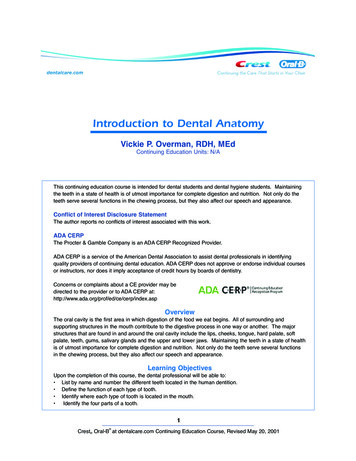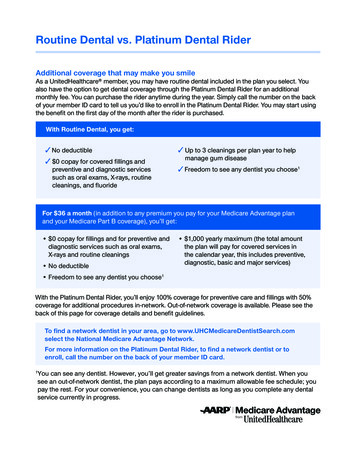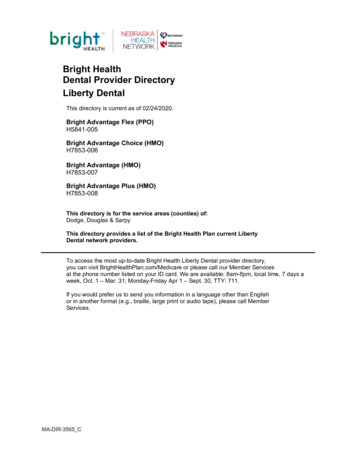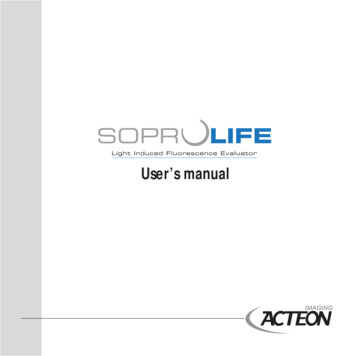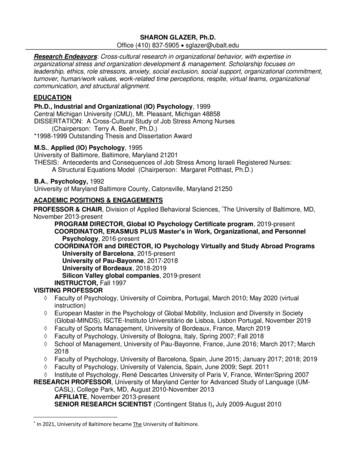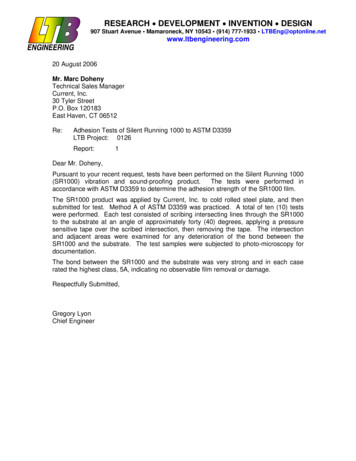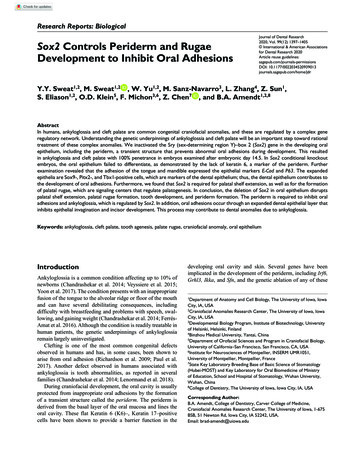
Transcription
939013Journal of Dental ResearchOral Adhesions in Sox2-Null MiceResearch Reports: BiologicalSox2 Controls Periderm and RugaeDevelopment to Inhibit Oral AdhesionsJournal of Dental Research2020, Vol. 99(12) 1397 –1405 International & American Associationsfor Dental Research 2020Article reuse 34520939013journals.sagepub.com/home/jdrY.Y. Sweat1,2, M. Sweat1,2 , W. Yu1,2, M. Sanz-Navarro3, L. Zhang4, Z. Sun1,S. Eliason1,2, O.D. Klein5, F. Michon3,6, Z. Chen7 , and B.A. Amendt1,2,8AbstractIn humans, ankyloglossia and cleft palate are common congenital craniofacial anomalies, and these are regulated by a complex generegulatory network. Understanding the genetic underpinnings of ankyloglossia and cleft palate will be an important step toward rationaltreatment of these complex anomalies. We inactivated the Sry (sex-determining region Y)–box 2 (Sox2) gene in the developing oralepithelium, including the periderm, a transient structure that prevents abnormal oral adhesions during development. This resultedin ankyloglossia and cleft palate with 100% penetrance in embryos examined after embryonic day 14.5. In Sox2 conditional knockoutembryos, the oral epithelium failed to differentiate, as demonstrated by the lack of keratin 6, a marker of the periderm. Furtherexamination revealed that the adhesion of the tongue and mandible expressed the epithelial markers E-Cad and P63. The expandedepithelia are Sox9-, Pitx2-, and Tbx1-positive cells, which are markers of the dental epithelium; thus, the dental epithelium contributes tothe development of oral adhesions. Furthermore, we found that Sox2 is required for palatal shelf extension, as well as for the formationof palatal rugae, which are signaling centers that regulate palatogenesis. In conclusion, the deletion of Sox2 in oral epithelium disruptspalatal shelf extension, palatal rugae formation, tooth development, and periderm formation. The periderm is required to inhibit oraladhesions and ankyloglossia, which is regulated by Sox2. In addition, oral adhesions occur through an expanded dental epithelial layer thatinhibits epithelial invagination and incisor development. This process may contribute to dental anomalies due to ankyloglossia.Keywords: ankyloglossia, cleft palate, tooth agenesis, palate rugae, craniofacial anomaly, oral epitheliumIntroductionAnkyloglossia is a common condition affecting up to 10% ofnewborns (Chandrashekar et al. 2014; Veyssiere et al. 2015;Yoon et al. 2017). The condition presents with an inappropriatefusion of the tongue to the alveolar ridge or floor of the mouthand can have several debilitating consequences, includingdifficulty with breastfeeding and problems with speech, swallowing, and gaining weight (Chandrashekar et al. 2014; FerrésAmat et al. 2016). Although the condition is readily treatable inhuman patients, the genetic underpinnings of ankyloglossiaremain largely uninvestigated.Clefting is one of the most common congenital defectsobserved in humans and has, in some cases, been shown toarise from oral adhesion (Richardson et al. 2009; Paul et al.2017). Another defect observed in humans associated withankyloglossia is tooth abnormalities, as reported in severalfamilies (Chandrashekar et al. 2014; Lenormand et al. 2018).During craniofacial development, the oral cavity is usuallyprotected from inappropriate oral adhesions by the formationof a transient structure called the periderm. The periderm isderived from the basal layer of the oral mucosa and lines theoral cavity. These flat Keratin 6 (K6)–, Keratin 17–positivecells have been shown to provide a barrier function in thedeveloping oral cavity and skin. Several genes have beenimplicated in the development of the periderm, including Irf6,Grhl3, Ikka, and Sfn, and the genetic ablation of any of these1Department of Anatomy and Cell Biology, The University of Iowa, IowaCity, IA, USA2Craniofacial Anomalies Research Center, The University of Iowa, IowaCity, IA, USA3Developmental Biology Program, Institute of Biotechnology, Universityof Helsinki, Helsinki, Finland4Binzhou Medical University, Yantai, China5Department of Orofacial Sciences and Program in Craniofacial Biology,University of California–San Francisco, San Francisco, CA, USA6Institute for Neurosciences of Montpellier, INSERM UMR1051,University of Montpellier, Montpellier, France7State Key Laboratory Breeding Base of Basic Science of Stomatology(Hubei-MOST) and Key Laboratory for Oral Biomedicine of Ministryof Education, School and Hospital of Stomatology, Wuhan University,Wuhan, China8College of Dentistry, The University of Iowa, Iowa City, IA, USACorresponding Author:B.A. Amendt, College of Dentistry, Carver College of Medicine,Craniofacial Anomalies Research Center, The University of Iowa, 1-675BSB, 51 Newton Rd, Iowa City, IA 52242, USA.Email: brad-amendt@uiowa.edu
1398genes in the oral ectoderm results in oral adhesions leading tocleft palate (Richardson et al. 2014; Kousa et al. 2017;Hammond et al. 2019). These previous studies indicate thatankyloglossia may be related with the abnormal formation ofperiderm during development.We recently reported that the inactivation of Sox2 in the oralepithelium with the Pitx2Cre resulted in tooth agenesis anddefective invagination of developing tooth buds, whichremained at the surface of the oral epithelial layer (Sun et al.2016). Further examination of these embryos revealed thatthey also had a cleft palate and ankyloglossia. We found thatthe periderm was not well formed and poorly organized in thismouse model, resulting in ankyloglossia. Additionally, weshow that the oral adhesion is composed of the inappropriateadhesion of the tongue and dental epithelia, linking ankyloglossia with defects in dental development.Materials and MethodsMouse Lines and Embryonic StagingMouse experiments were performed in accordance with rulesprovided by the Office of Animal Resources at the Universityof Iowa. The Sox2Flox/Flox, Pitx2Cre, and ShhCre were describedin a previous publication (Liu et al. 2003; Taranova et al.2006; Sun et al. 2016). The Pitx2Cre/Sox2F/F mice are termedSox2CKO.Genotype Primers. Sox2 WT:Forward: 5′ GCTCTGTTATTGGAATCAGGCTGC 3′Reverse: 5′ CTGCTCAGGGAAGGAGGGG 3′Sox2 CKO:Forward: 5′ CAGCAGCCTCTGTTCCACATACAC 3′Reverse: 5′ CAACGCATTTCAGTTCCCCG 3′Tissue Fixation and Slide PreparationEmbryos were fixed in 4% PFA (ChemCruz) and embedded inparaffin; samples were sectioned at 7 µm with Thermo(HM325) microtome per previous reports (Sun et al. 2016).Journal of Dental Research 99(12)[R&D Systems]; Sox2 antibody, 1:50, AF2018 [R&D Systems];P63 antibody, 1:50 [Biocare Medical]; Loricrin, 1:500, 905101[BioLegend]; Keratin 6A, 1:500, 905702 [BioLegend];Desmoplakin, 1:50 [Bio-Rad]) overnight at 4 C. Slides werewashed with 1X PBS, and secondary antibody (LifeTechnologies) was applied for 30 min, incubated with DAPIsolution (Thermo Scientific), and mounted with cover slips.Confocal pictures were taken with a ZEISS 700 confocalmicroscope and Zen imaging software.IdU/CIdU Labeling AssayCIdU was injected 24 h prior to harvesting embryonic day 15.5(E15.5) embryos (i.e., E14.5), and IdU was injected 1 h prior toharvesting embryos. Both analogues were injected at 100-µg/gbody weight of the pregnant female mouse. Embryos were thenharvested and embedded into paraffin with the approachdescribed previously. Staining for IdU/CIdU was performed inaccordance with a previous study (Tuttle et al. 2010; Sun et al.2016).Quantitative Reverse Transcription PolymeraseChain ReactionTotal RNAs were extracted with the RNeasy Mini Kit fromQiagen and reverse transcribed into cDNA with PrimeScriptRT Reagent Kit (TaKaRa).Polymerase Chain Reaction Primers. SOX2:Forward: 5′ GCCGAGTGGAAACTTTTGTCG 3′Reverse: 5′ GGCAGCGTGTACTTATCCTTCT 3′KRT6A:Forward: 5′ TGCTGCCTACATGAACAAGG 3′Reverse: 5′ TGTCTGAGATGTGGGTCTGC 3′ChIPHematoxylin and Eosin StainingThe chromatin immunoprecipitation (ChIP) assay was performedon GMSMK cells with a ChIP assay kit (17-295; Millipore) andSox2 Ab (R&D systems). ChIP primers were selected around thepredicted Sox2 binding site and a control region, and regionswere amplified by polymerase chain reaction.Sections were stained by hematoxylin and eosin as previouslydescribed (Sun et al. 2016).ChIP Primers. Negative control:Immunofluorescence Stainingand Confocal ImagingSlides were subjected to citric acid antigen retrieval, washed 2times with 1X PBS for 5 min, and blocked with 20% donkeyserum in PBS for 30 min at room temperature. Slides were thenincubated with primary antibody (Pitx2 antibody, 1:50, AF7388Forward: 5′ CTTCTTCCAAATATGCCCGTCAGTG 3′Reverse: 5′ CACATTGAGTTTGACGCATGTTC 3′SOX2 BS:Forward: 5′ CCAAATGTTGGAGAAATGGGACTG 3′Reverse: 5′ GTTTACAGAGGAATGAGCTTCACTTCTCC 3′
Oral Adhesions in Sox2-Null MiceStatistical Analysis for ExperimentsEach experiment was repeated 3 times with at least 3 mutantand control embryos for mouse studies. The results are shownas the mean standard error of the mean (SEM), and the analyses were performed with an independent 2-tailed t test.ResultsSox2CKO Embryos Develop Ankyloglossiadue to Defects in Periderm FormationWe examined the E13.5, E14.5, E15.5, and E18.5 developmental stages of murine embryos with sagittal sections of control(Pitx2Cre) and Pitx2Cre/Sox2F/F (Sox2CKO) embryos. Interestingly,a delay was noted in the invagination of the dental epithelium inthe Sox2CKO embryos (Fig. 1A, B). By E14.5, the delay in dentalepithelial invagination may have caused the fusion of the tip ofthe tongue to the mandible (Fig. 1D, arrow). The apparentfusion of the dental and tongue epithelium results in a furtherdisruption of incisor dental epithelial cell invagination. Thisankyloglossia phenotype was present at E15.5 and E18.5 ascompared with the control embryos (Fig. 1F, F′, H, H′). Theankyloglossia phenotype was also observed in the ShhCreSox2F/F embryos, demonstrating that 2 independent murine Crelines created similar Sox2CKO phenotypes (Fig. 4E′).To determine the nature of the tissue connecting the tongueand the mandible, we performed immunostaining for markersof different cell types found in the developing oral mucosa, andwe determined that the adhesion tissue connecting the mandible epithelium to the tongue epithelium in Sox2CKOembryosexpressed E-cadherin (Fig. 2A, B). We next stained for K6, aprotein expressed by the transient periderm layer. While theE15.5 control embryos had a well-formed layer of K6 periderm cells on the surface of the developing mandible (Fig. 2C,C′), this layer was poorly formed in Sox2CKOembryos (Fig. 2D,D′), and only a few K6 cells were identified in the anteriormandibular oral epithelium. Interestingly, the K6 peridermlayer identified in the controls at E15.5 also expressed Sox2,suggesting a potential role for Sox2 in the formation of theperiderm. To verify the results of the K6 staining, we nextstained for Grhl3, a reported marker of the periderm (Fig. 2E,F). In Sox2CKO embryos, Grhl3 protein levels were significantly reduced in regions where Sox2 is expressed as compared with the control.Previous work has demonstrated that cell adhesion complexes, including desmosomes, are localized between basalcells but are not present on the apical surface of the epidermis,thus preventing the abnormal adhesion of opposing epitheliallayers in the developing skin (Richardson et al. 2014). Todetermine if ectopic apical organization of desmosomes contributed to the ankyloglossia phenotype that we observed in theSox2CKO embryos, we stained for Desmoplakin, a componentof desmosomes. In control embryos, staining for Desmoplakinrevealed that it was not localized apically on either the mandibular or tongue epithelia (Fig. 2G). Interestingly, in Sox2CKOembryos, Desmoplakin expression was no longer restricted,1399and the tongue and mandibular epithelial layers were connected by cells with unpolarized Desmoplakin localization(Fig. 2H). These data demonstrate that the malformation ofthe periderm resulting from the inactivation of Sox2 allowsfor the mislocalization of desmosomes, resulting in epithelialadhesion.Costaining of P63 and Sox2 in control E15.5 embryos (Fig.2I, I′) revealed a well-organized single layer of P63 , Sox2basal cells and a suprabasal Sox2 , P63 layer. The peridermlayer separates the suprabasal layer from the oral cavity.Interestingly, in Sox2CKO embryos, the P63 basal layer waspoorly organized. The disorganized P63 cells did not give riseto the K6 periderm layer observed in control embryos butinstead expanded and became attached to the tongue epithelium (Fig. 2J, J′).Deletion of Sox2 Results in Increased Proliferationof the Dental Epithelium within the Oral AdhesionWe examined E15.5 control and Sox2CKO embryos for differences in proliferation using injections of the 2 thymidine triphosphate analogues, CIdU (24 h prior to sacrifice) and IdU(1 h prior to sacrifice), coupled with immunofluorescencestaining to label proliferating cells (Fig. 2K, L). Neither thecontrol nor the Sox2CKO oral epithelial region had large numbers of proliferating cells 1 h prior to sacrifice (green),although the Sox2CKO embryo had a much greater number ofCIdU cells (red), indicating that the oral epithelium was proliferating 24 h prior to harvesting the embryos (quantification,Fig. 2M).Loricrin is a differentiation marker expressed in mammalian stratified epithelia that contributes to barrier function(Nithya et al. 2015). Interestingly, while the control embryoshad a coherent layer of Loricrin protein marking the superiorlayer of the oral and dental epithelium, Sox2CKO embryos failedto develop the Loricrin cell layer in the region of the mandiblefused to the tongue (Fig. 2N, O), the same adhesion regionpreviously shown to have greater numbers of CIdU cells.Thus, we concluded that the oral adhesion disrupts the formation of the Loricrin layer specifically at the adhesion region ofthe oral mucosa.Oral Adhesion Is Composed of Dental Epithelial CellsA major unanswered question concerning oral adhesions is thetissue type that directly interacts with the tongue epithelium.We stained for known dental epithelial marker expression inthe oral adhesion because the oral adhesion connecting thetongue and the mandible occurs at the lower incisor regioncomprising the oral and dental epithelium. Other groups havedemonstrated that pathogenic oral adhesions resulting in cleftcan occur at the molar tooth buds (Richardson et al. 2006;Richardson et al. 2014; Paul et al. 2017). To determine if thedental epithelial tissue might participate in the formation ofadhesions, we stained for Sox9, which is specifically expressedin the enamel organ of the developing lower incisor in control
1400Journal of Dental Research 99(12)Figure 1. Sox2CKO embryos exhibit ankyloglossia beginning at embryonic day 14.5 (E14.5). (A, A′) Sagittal sections and hematoxylin and eosin stainingof E13.5 embryos reveal normal development of the tongue in control (Pitx2Cre) embryos. The tongue is connected to the mandible in the posteriorregion of the mandible. (B, B′) In Sox2CKO embryos, the tongue shows no signs of fusion in the anterior region at E13.5. (C, C′) Hematoxylin andeosin staining reveals that in control embryos, the tongue and the mandible are separated in the anterior region at E14.5. (D, D′) In Sox2CKO embryos,the anterior portion of the tongue is fused to the mandible with an oral adhesion (black arrow). (E, E′) At E15.5, the tongue is elongated and clearlyseparated from the mandible in control embryos. (F, F′) Fusion of the tongue to the mandible persists in Sox2CKO embryos. The fusion is located at theanterior region of the tongue above the tooth bud region. (G, G′) In control E18.5 embryos, tongue development proceeds, and the anterior tongue isseparated from the mandible. (H, H′) In Sox2CKO embryos, ankyloglossia persists at E18.5 (black arrow). Dotted lines in A′-D′ represent the developingdental epithelium, which is smaller and fails to invaginate in Sox2CKO embryos. F′ Arrows denote ankyloglossia. Scale bar 100 μm.embryos (Fig. 3A, A′). Indeed, we demonstrate that many ofthe oral adhesion cells express the Sox9 protein (Fig. 3B, B′).We stained for Pitx2 and Tbx1, which are both markers ofthe dental and oral epithelial tissue in control embryos (Fig.3C, C′, E). Interestingly, the cells composing the oral adhesionexpressed these markers associated with the dental epithelium(Fig. 3D, D′, E′). Thus, we conclude that the oral adhesion iscomposed of expanded dental epithelial cells.Sox2 Regulates the Palate Rugae SignalingCenter and PalatogenesisWe sectioned the heads of E15.5 control and Sox2CKO embryosin the coronal orientation and found that whereas control E15.5embryos had a well-formed, completely fused palate (Fig.4A–C), palate closure had not occurred in Sox2CKO embryos.Shelf extension, the process by which the 2 palate shelves meetat the midline at E15.5, had not occurred, nor did it occur atlater stages (Fig. 4A′–C′). Furthermore, the ShhCre-GFP/Sox2fl/flE18.5 embryos had a cleft palate (Fig. 4D, D′) and ankyloglossia (Fig. 4E, E′). In addition, these embryos lacked palaterugae. Thus, using the Pitx2Cre and ShhCre lines resulted insimilar Sox2CKO phenotypes.Further investigation with sagittal sections taken from themidline of control (Fig. 4F, G) and Sox2CKO embryos (Fig. 4F′,G′) revealed that the mutant embryos lacked well-defined palate rugae (denoted with arrows in control embryos), which aresources of signaling molecules during palatogenesis (Welshand O’Brien 2009; Lin et al. 2011). Lef-1, which is specificallyexpressed in the palate rugae of E14.5 control embryos (Fig.
Oral Adhesions in Sox2-Null Mice1401Figure 2. Loss of Sox2 results in oral adhesion and impaired formation of the periderm. (A) In control embryos (embryonic day 15.5 [E15.5]),staining for E-cadherin labels the tongue, oral, and dental epithelial tissues. (B) When Sox2 is ablated, E-cadherin labels the same structures, includingthe lower incisor, which fails to invaginate in these embryos. The oral adhesion, which is indicated with a black arrow, is also clearly expressingE-cadherin, demonstrating that the adhesion is epithelial tissue. (C, C′) In control embryos, Sox2 protein is labeled in the tongue and oral epithelialtissues, including the vestibule lamina. Staining for Keratin 6 also labels the periderm, as indicated by the green arrow. (D, D′) When Sox2 is ablatedwith Pitx2Cre, Sox2 protein is no longer labeled in the tongue and oral epithelial tissues. Additionally, the Keratin 6–positive periderm structure is almostcompletely ablated. (E) Grhl3 protein is expressed in multiple oral epithelia layers and highly expressed in the periderm of control embryos. (F) InSox2CKO embryos, Grhl3 expression was diminished. (G) In control embryos, Desmoplakin protein is not expressed on the apical side of the mostsuperficial oral epithelia. (H) In Sox2CKO embryos, Desmoplakin is ectopically expressed on the apical layer of the tongue and oral epithelia and withinthe oral adhesion connecting the tongue and mandible. (I, I′) P63 and Sox2 double staining reveals a well-ordered P63 basal layer (arrow). Superior tothe basal layer are Sox2 and P63 double-positive cells. Finally, the periderm, the most superficial layer, contains only Sox2 protein. (J, J′) When Sox2 isablated, the well-ordered basal layer is disrupted. The oral adhesion is P63 positive. (K) Pregnant mice timed to E14.5 were injected with CIdU, wereinjected with IdU 23 h later, and sacrificed 1 h later. (L) In Sox2CKO littermates, the oral adhesion is CIdU positive, indicating that the oral epithelial layerwas actively proliferating at E14.5. (M) The number of CIdU cells is significantly higher in Sox2CKO embryos as compared with the control. **P 0.01.Values are presented as mean SEM. (N) Loricrin is expressed in the space sep
By E14.5, the delay in dental epithelial invagination may have caused the fusion of the tip of the tongue to the mandible (Fig. 1D, arrow). The apparent fusion of the dental and tongue epithelium results in a further disruption of incisor dental epithel
